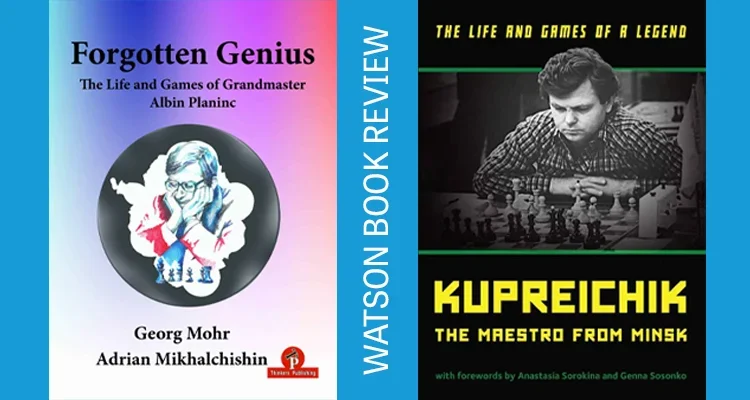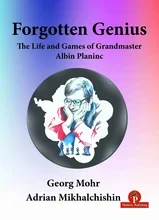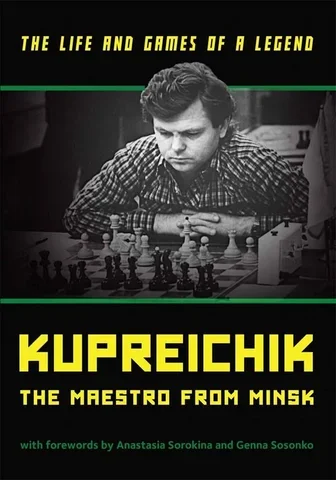
- Mohr, Georg, and Adrian Mikhalchishin. Forgotten Genius: The Life and Games of Grandmaster Albin Planinc. Thinkers Publishing, 2021. ISBN-13: 978-9464201291, 439 pages. (Buy now at uscfsales.com)
- Iglesias, Pablo. Apologia of the Unexpected: Selected Games of Albin Planinc. Self-published, 2020. ISBN-13 979-8585078118, 196 pages.
- Multiple authors. Kupreichik: The Maestro from Minsk. London Chess Centre Publishing, 2021. ISBN: 978-0948443961, 325 pages
Originally published in the March 2022 issue of Chess Life.
When I was starting out in chess, games collections and tournament books constituted a majority of the high-quality chess books available — the ones that could teach a curious youngster something beyond the basics. As time went on, publishers began to produce a large variety of books about specialized topics such as tactics, endings, strategy, and openings, while the tournament book became a relative rarity. But it remained a major event when a world champion or leading grandmaster produced a book of annotated games. I venture to say that most of the best players of the pre-computer era learned as much or more from those books as from any other part of their studies.
Recently we’ve been treated to numerous books about legends who contended for the world championships. But in a pleasant surprise, authors have also been exploring lesser-known players of significant talent who, despite their less exalted results, have made original contributions and left a lasting impression on their contemporaries. I’ll be discussing a few of those here.

Few of today’s young players have heard of the Slovenian GM Albin Planinc (1944-2008), but there was a time during which he was a kind of hero for fans of romantic attacking chess all over the world. One of those was GM Georg Mohr, a student of Planinc’s, who is a kind of lead author for the book. Mohr describes Planinc’s games as “imbued with incredible energy… with so much of what most people think is beautiful in chess.” In the opening, Planinc would play to create dynamic chances, often without regard to safety or material. It wasn’t always the most practical style, but it gained him many fans.
When I was growing up, Planinc’s miniature masterpiece versus Vaganian was widely known, but I wonder how many of today’s young players have seen it. Oddly enough, Black’s opening treatment is still theoretically relevant over 40 years later.
[pgn][Event "Christmas Congress 1974/75-50 Premier"]
[Site "Hastings"]
[Date "1975.01.02"]
[Round "5"]
[White "Vaganian, Rafael A"]
[Black "Planinc, Albin"]
[Result "0-1"]
[ECO "A32"]
[Annotator "Watson"]
[PlyCount "44"]
[EventDate "1974.12.28"]
[EventType "tourn"]
[EventRounds "15"]
[EventCountry "ENG"]
[EventCategory "9"]
[SourceTitle "Chess Life March 2022"]
[SourceDate "2022.03.01"]
[SourceVersion "1"]
[SourceVersionDate "2022.03.01"]
[SourceQuality "1"]1. d4 Nf6 2. c4 c5 3. Nf3 cxd4 4. Nxd4 e6 5. Nc3 Bb4 6. Ndb5 O-O 7. a3 Bxc3+ 8.
Nxc3 d5 9. Bg5 h6 $1 {Black offers a pawn for superior development and
activity.} 10. Bxf6 (10. Bh4 {can be met by} d4 11. Ne4 g5 12. Nxf6+ Qxf6 13.
Bg3 e5 14. h4 Bf5) 10... Qxf6 11. cxd5 exd5 12. Qxd5 Rd8 13. Qf3 Qb6 14. Rd1
Rxd1+ 15. Nxd1 {White has everything covered and an extra pawn.} Nc6 16. Qe3 $6
{Very logical, offering an exchange of queens and apparently threatening Qe8+.}
(16. e3 Be6 17. Be2 Rd8 18. O-O (18. b4 $2 Nxb4) 18... Rd2 {gives Black the
seventh rank with active pieces and more than enough for a pawn.}) 16... Nd4 $1
17. Qe8+ Kh7 18. e3 (18. Qxf7 $2 {wins a second pawn, but} Bf5 19. e3 Nc2+ {
hunts down the king, e.g.,} 20. Kd2 (20. Ke2 Bg6 21. Qf4 Qb5+ 22. Kf3 Qc5 23.
Kg3 Rf8) 20... Rd8+ 21. Kc1 Bg6 22. Qc4 Nxa3) 18... Nc2+ 19. Kd2 {Now White
threatens Bd3+ and appears safe. Planinc reveals the point of his previous
moves:} Bf5 $3 {[#]} 20. Qxa8 Qd6+ 21. Kc1 ({Without going into the details,}
21. Kc3 {will also lose to} Qe5+ $1 22. Kb3 (22. Kd2 Qd5+ 23. Kc3 Qa5+ $1 24.
b4 Qxa3+ 25. Kd2 Qxb4+) 22... Na1+ $1 23. Kb4 (23. Ka2 Qd5+) 23... b6 24. Qc6
Bd7 $1) 21... Na1 {Threatening ...Nb3 mate!} 22. Qxb7 $2 {So logical. [#]
[Place diagram after note]} (22. Bc4 {holds for a while, although Black gets
all the winning chances after} Qc6 23. Nc3 Qxc4 24. Qd8 $1 Nb3+ 25. Kd1 Qg4+
26. Ne2 {All forced.} Qe4 $1 27. Ke1 Qb1+ 28. Qd1 Qxb2) 22... Qc7+ $1 {Lovely.}
(22... Qc7+ 23. Qxc7 {is met by} Nb3#) 0-1[/pgn]
Planinc was plagued by what the authors call “a nervous disease” for the last 30 years of his life and played almost no chess. But even in his generally low-quality games from his last international tournament, he showed his tactical flair:
[pgn][Event "Rubinstein Memorial-17"]
[Site "Polanica Zdroj"]
[Date "1979.08.14"]
[Round "8"]
[White "Planinc, Albin"]
[Black "Pokojowczyk, Jerzy"]
[Result "1-0"]
[ECO "B99"]
[BlackElo "2365"]
[Annotator "Watson"]
[PlyCount "53"]
[EventDate "1979.08.06"]
[EventType "tourn"]
[EventRounds "15"]
[EventCountry "POL"]
[EventCategory "8"]
[SourceTitle "Chess Life March 2022"]
[SourceDate "2022.03.01"]
[SourceVersion "1"]
[SourceVersionDate "2022.03.01"]
[SourceQuality "1"]1. e4 c5 2. Nf3 d6 3. d4 cxd4 4. Nxd4 Nf6 5. Nc3 a6 6. Bg5 e6 7. f4 Be7 8. Qf3
h6 9. Bh4 Qc7 10. O-O-O Nbd7 11. Be2 g5 12. fxg5 Ne5 13. Qe3 Nfg4 14. Bxg4 Nxg4
15. Qd2 hxg5 16. Bxg5 Nf2 $2 {Tricky, but this gets crushed:} 17. Bxe7 Nxd1 {
[#]} 18. Nd5 $3 exd5 19. Bf6 Rh5 20. exd5 {White is still a rook down but the
attack is unstoppable.} Bg4 (20... Rxd5 21. Re1+ Re5 22. Qg5 $3 {and Black can
resign.}) 21. Re1+ Kf8 22. h3 $1 {A slow move which highlights Black's
helplessness:} Re8 23. hxg4 Rxe1 24. Qxe1 Nxb2 25. Kxb2 Rxd5 26. g5 Ra5 27. g6
1-0[/pgn]
The book is primarily a games collection, but it also has a great deal of biographical information. The descriptions of his opponents, along with the many photos of leading players of his day, should appeal to chess history buffs. For chess book collectors, I should mention that there is another (self-published) book of Planinc’s games that appeared not long before this one: Pablo Iglesias’ Apologia of the Unexpected: Selected Games of Albin Planinc. It is a much shorter, modest effort, written with an explicit appeal to other writers to examine Planinc’s career more thoroughly. I think that Iglesias will be happy that Mohr and Mikhalchishin have done precisely that.
If Planinc was known for attacking chess, GM Viktor Kupreichik (1949-2017) was equally aggressive, and uncompromising to a fault. He was also, like Planinc, a sort of folk hero for his Belorussian fans.

In part one of Kupreichik: The Maestro from Minsk, no fewer than 24 prominent players write short chapters in which some discuss their impressions of Kupreichik and present from one to five of his games apiece. Along with a number of younger GMs, there are contributions from Karpov, Beliavsky, Suetin, Tukmakov, Sosonko, Gelfand, Kasparov, Sveshnikov, Smirin, Mamedov, Balashov and Vaganian. This is followed by Part Two with 46 games annotated by Kupreichik himself over the years, sometimes with Informant-style notes supplemented by verbal notes added by the editors.
Several of the contributors point to Kupreichik’s over-ambitiousness as his curse. In two major top-class tournaments, for example, he started with five consecutive victories, but his refusal to play for the occasional draw (or accept draws when offered) led to mental fatigue and drastic collapses. You can see this in the games of this book where, after lengthy and monstrously complicated struggles, even against world-class players, he rejects drawing lines and risks losing.
The following game isn’t exceptionally flashy, but illustrates Kupreichik’s mastery of the King’s Indian Defense and his avoidance of simplification in pursuit of attack.
[pgn][Event "URS"]
[Site "Soviet Union"]
[Date "1980.??.??"]
[Round "?"]
[White "Dorfman, Josif D"]
[Black "Kupreichik, Viktor D"]
[Result "0-1"]
[ECO "E97"]
[WhiteElo "2540"]
[BlackElo "2535"]
[Annotator "Watson"]
[PlyCount "58"]
[EventDate "1980.??.??"]
[EventType "game"]
[EventRounds "9"]
[EventCountry "URS"]
[SourceTitle "Chess Life March 2022"]
[SourceDate "2022.03.01"]
[SourceVersion "1"]
[SourceVersionDate "2022.03.01"]
[SourceQuality "1"]1. d4 Nf6 2. Nf3 g6 3. c4 Bg7 4. Nc3 O-O 5. e4 d6 6. Be2 e5 7. O-O Nc6 8. d5
Ne7 9. Bd2 Nh5 10. g3 f5 11. exf5 Nxf5 12. Ne4 Nf6 13. Bd3 Bh6 14. Bc3 $5 {
My initial instincts in a position like this is that White should have a small
positional advantage, but the best King's Indian players are comfortable with
Black. Here a slow move like [#] [Diag after note] Kupreichik now finds an
astonishing reorganization which, above all, keeps maximum complications on
the board:} (14. b4 {might have kept better control over the kingside squares.}
) 14... Ng7 $5 {What a retreat! At first this is the fourth choice by my
engine, but rather soon it puts it on an equal level with several other moves.}
({Kovalev gives} 14... Nxe4 15. Bxe4 Qf6 $11 {and says "but this is too
conventional and tedious for Kupreichik".}) 15. Nfd2 Ngh5 $1 16. Re1 Bf5 17. c5
(17. f3 Qd7 18. Bf1 Nxe4 19. Nxe4 Qf7 20. Nf2 Nf6 {and the engine still calls
it equal}) 17... Qd7 18. cxd6 cxd6 19. f3 Rf7 {Every piece in the attack.} 20.
Nc4 $4 (20. a4 $5 Raf8 21. Ra3) (20. Qe2 Raf8 $15) 20... Bxe4 21. fxe4 (21.
Bxe4 Nxe4 22. fxe4 Raf8 23. Qe2 Qh3 24. Qg2 Qc8 $1 25. Na3 Qc5+ 26. Kh1 Rf2 27.
Qh3 b5 {will win a piece and then some}) 21... b5 22. Na3 {[#]} ({The notes
suggest} 22. Nxe5 dxe5 23. Bxe5 {, but among other ideas,} Raf8 24. Qe2 Ng4 {
is extremely strong:} 25. Bd4 (25. Bxb5 Qc8 {and ...Rf2}) 25... Nxh2 26. Qxh2 (
26. Kxh2 Rf3 27. Rf1 Qg4) 26... Rf3 27. Bf1 Rxg3+ 28. Bg2 Qg4 29. Rf1 Bf4 $19)
22... Nxg3 $1 23. hxg3 Qh3 24. Qf3 Ng4 25. Qg2 Qh5 26. Qh1 Rf3 $1 27. Qxh5
Rxg3+ 28. Kh1 gxh5 29. Be2 (29. Bf1 Nf2+ 30. Kh2 Bf4 31. Bg2 h4 $1 32. Re2 h3
$19) 29... Rh3+ (29... Rh3+ 30. Kg1 Be3+ 31. Kf1 Rh1+ 32. Kg2 Rh2+ 33. Kg3 Bf4+
34. Kf3 Rf2#) 0-1[/pgn]
Here’s another King’s Indian, one that Kovalev calls “one of the best King’s Indian games of all time.” I won’t clutter it with notes, but suffice it to say that all of Black’s play is sound, as is White’s up to his final defensive lapse.
[pgn][Event "URS-ch49 Final"]
[Site "Frunze"]
[Date "1981.12.??"]
[Round "7"]
[White "Agzamov, Georgy"]
[Black "Kupreichik, Viktor D"]
[Result "0-1"]
[ECO "E73"]
[BlackElo "2575"]
[Annotator "Watson"]
[PlyCount "74"]
[EventDate "1981.11.28"]
[EventType "tourn"]
[EventRounds "17"]
[EventCountry "URS"]
[EventCategory "12"]
[SourceTitle "Chess Life March 2022"]
[SourceDate "2022.03.01"]
[SourceVersion "1"]
[SourceVersionDate "2022.03.01"]
[SourceQuality "1"]1. d4 Nf6 2. c4 g6 3. Nc3 Bg7 4. e4 d6 5. Be2 O-O 6. Bg5 Nbd7 7. Qd2 e5 8. d5
Nc5 9. f3 Bd7 10. h4 Qe8 11. g4 h5 12. O-O-O hxg4 13. Bxf6 Bxf6 14. fxg4 Qd8
15. Qe1 Bg7 16. Nh3 f5 17. exf5 gxf5 18. g5 b5 $1 19. cxb5 a6 20. b4 $6 {
Tempting, but Black can get too much activity for a piece.} (20. h5 {would get
White's counterattack moving.}) 20... axb5 $1 21. bxc5 b4 22. Nb1 Rxa2 23. Bc4
Ra5 24. c6 {[#]} Qb8 $3 {This second piece sacrifice is the key.} 25. Qe2 {
A logical defense.} ({After} 25. cxd7 Rc5 {, c4 hangs and White's king is
exposed. Okay, the computer finds the miraculous} 26. Rd4 $3 {, leading to
balanced chances after} Qb5 $1 (26... exd4 $2 27. Qe6+ Kh8 28. Nf4 Rxc4+ 29.
Kd1 $18) 27. Kd1 Rxc4 ({or} 27... Qa4+ 28. Kd2 Qa1 $13) 28. Rxc4 Qxc4 29. Nd2
Qb5 30. Qe2 Qxd7 {'=' according to my engine. But who would actually play this
way as White?}) 25... b3 $1 26. cxd7 Qb4 27. Rd2 e4 28. Nf4 $2 ({White had to
return the piece with} 28. Kd1 Ra1 29. Bd3 exd3 30. Qxd3 {with dynamic
equality.}) 28... Ra1 29. Rh3 Bc3 $1 {There's no good defense now.} 30. Bxb3
Bxd2+ 31. Qxd2 Rxb1+ 32. Kxb1 Qxd2 33. Ne6 Rb8 34. d8=Q+ Rxd8 35. Nxd8 e3 36.
Ne6 e2 37. Rh1 f4 $1 0-1[/pgn]
Kupreichik: The Maestro from Minsk is primarily a games collection, but includes biographical information and stories provided by other players, as well as a nice photo section, exercises, and personal essays by family members.
Both these books offer a plethora of exciting, complicated, back-and-forth struggles. One impression I get is that, before the rise of the engines, it was easier to achieve unclear tactical positions from forcing lines the opening and to survive, even when accepting an objectively worse position. Today, players are better at finding harmless continuations that frustrate the attacker, and when they do allow tactical lines, they are more likely to have a concrete solution prepared to either refute or neutralize them.
I’m not sure if we will ever again have players like this so consistently succeed in throwing even the highest-level players upon their own resources, but these books make for great reading and will inspire attacking players everywhere.
Categories
Archives
- December 2025 (20)
- November 2025 (29)
- October 2025 (39)
- September 2025 (27)
- August 2025 (29)
- July 2025 (43)
- June 2025 (25)
- May 2025 (24)
- April 2025 (29)
- March 2025 (29)
- February 2025 (20)
- January 2025 (24)
- December 2024 (34)
- November 2024 (18)
- October 2024 (35)
- September 2024 (23)
- August 2024 (27)
- July 2024 (44)
- June 2024 (27)
- May 2024 (31)
- April 2024 (51)
- March 2024 (34)
- February 2024 (25)
- January 2024 (26)
- December 2023 (29)
- November 2023 (26)
- October 2023 (37)
- September 2023 (27)
- August 2023 (37)
- July 2023 (47)
- June 2023 (33)
- May 2023 (37)
- April 2023 (45)
- March 2023 (37)
- February 2023 (28)
- January 2023 (31)
- December 2022 (23)
- November 2022 (32)
- October 2022 (31)
- September 2022 (19)
- August 2022 (39)
- July 2022 (32)
- June 2022 (35)
- May 2022 (21)
- April 2022 (31)
- March 2022 (33)
- February 2022 (21)
- January 2022 (27)
- December 2021 (36)
- November 2021 (34)
- October 2021 (25)
- September 2021 (25)
- August 2021 (41)
- July 2021 (36)
- June 2021 (29)
- May 2021 (29)
- April 2021 (31)
- March 2021 (33)
- February 2021 (28)
- January 2021 (29)
- December 2020 (38)
- November 2020 (40)
- October 2020 (41)
- September 2020 (35)
- August 2020 (38)
- July 2020 (36)
- June 2020 (46)
- May 2020 (42)
- April 2020 (37)
- March 2020 (60)
- February 2020 (38)
- January 2020 (45)
- December 2019 (34)
- November 2019 (35)
- October 2019 (42)
- September 2019 (45)
- August 2019 (56)
- July 2019 (44)
- June 2019 (35)
- May 2019 (40)
- April 2019 (48)
- March 2019 (61)
- February 2019 (39)
- January 2019 (30)
- December 2018 (29)
- November 2018 (51)
- October 2018 (45)
- September 2018 (29)
- August 2018 (49)
- July 2018 (35)
- June 2018 (31)
- May 2018 (39)
- April 2018 (31)
- March 2018 (26)
- February 2018 (33)
- January 2018 (30)
- December 2017 (26)
- November 2017 (24)
- October 2017 (30)
- September 2017 (30)
- August 2017 (31)
- July 2017 (28)
- June 2017 (32)
- May 2017 (26)
- April 2017 (37)
- March 2017 (28)
- February 2017 (30)
- January 2017 (27)
- December 2016 (29)
- November 2016 (24)
- October 2016 (32)
- September 2016 (31)
- August 2016 (27)
- July 2016 (24)
- June 2016 (26)
- May 2016 (19)
- April 2016 (30)
- March 2016 (36)
- February 2016 (28)
- January 2016 (32)
- December 2015 (26)
- November 2015 (23)
- October 2015 (16)
- September 2015 (28)
- August 2015 (28)
- July 2015 (6)
- June 2015 (1)
- May 2015 (2)
- April 2015 (1)
- February 2015 (3)
- January 2015 (1)
- December 2014 (1)
- July 2010 (1)
- October 1991 (1)
- August 1989 (1)
- January 1988 (1)
- December 1983 (1)







